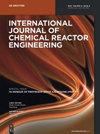Numerical investigations on sc-CO2 gas sequestration in layered heterogeneous deep saline aquifers
IF 1.6
4区 工程技术
Q3 Chemical Engineering
International Journal of Chemical Reactor Engineering
Pub Date : 2023-06-15
DOI:10.1515/ijcre-2023-0041
引用次数: 0
Abstract
Abstract Carbon capture and storage (CCS) technology is regarded as the feasible solution to mitigate CO2 emissions from the burning of fossil fuels in large-scale industries to meet energy demand. The storage of CCS requires the injection of CO2 gas captured from bulk sources into geological formations. Deep saline aquifers are the largest identified storage potential formations for injecting high volumes of gas. The safe storage of CO2 gas requires a better understanding of the gas migration and pore pressure buildup in the aquifer. In the present work, a numerical has been developed to study the various factors impacting the CO2 gas migration in the formation of both homogeneous and multi-layered deep saline aquifers. The numerical model has been history matched with an analytical solution and the plume thickness data reported by Nordbotten, J. M., M. A. Celia, and S. Bachu. (2005). “Injection and Storage of CO2 in Deep Saline Aquifers: Analytical Solution for CO2 Plume Evolution during Injection.” Transport in Porous Media 58 (3): 339–60. The saturation distribution and pressure buildup in the aquifer are different for each case. The relative permeability of gas increases in the homogeneous case. The drainage efficiency increases along with injection time in any formation. However, the drainage process is less in layered formation compared with homogeneous formation. The parameterized storage efficiency factor (Ɛ) is calculated to understand the storage capacity of the aquifer along the lateral direction near to injection well. The formations having low permeability in the top and below layers of the aquifer, the storage efficiency factor is high indicating more amount of gas is stored.层状非均质深层含水层sc-CO2气体固存的数值研究
碳捕集与封存(CCS)技术被认为是减少大规模工业化石燃料燃烧产生的二氧化碳排放以满足能源需求的可行解决方案。CCS的储存需要将从大量来源捕获的二氧化碳气体注入到地质构造中。深层咸水层是已确定的可注入大量天然气的最大潜在储层。二氧化碳气体的安全储存需要更好地了解气体在含水层中的运移和孔隙压力的积累。本文采用数值方法研究了均匀层和多层深层咸水含水层形成过程中影响CO2气体运移的各种因素。该数值模型与解析解以及Nordbotten、j.m.、m.a. Celia和S. Bachu报告的烟柱厚度数据进行了历史匹配。(2005)。深层盐水含水层中CO2的注入和储存:注入过程中CO2羽流演化的分析解决方案。多孔介质的输运研究[j] .石油学报(自然科学版);每种情况下含水层的饱和度分布和压力积累是不同的。在均匀情况下,气体的相对渗透率增加。在任何地层中,排液效率都随着注入时间的增加而增加。与均质地层相比,层状地层的排水作用较少。通过计算参数化蓄水效率因子(Ɛ)来了解注水井附近水平方向含水层的蓄水能力。含水层上部和下部渗透率较低的地层,储气效率系数较高,表明储气量较大。
本文章由计算机程序翻译,如有差异,请以英文原文为准。
求助全文
约1分钟内获得全文
求助全文
来源期刊
CiteScore
2.80
自引率
12.50%
发文量
107
审稿时长
3 months
期刊介绍:
The International Journal of Chemical Reactor Engineering covers the broad fields of theoretical and applied reactor engineering. The IJCRE covers topics drawn from the substantial areas of overlap between catalysis, reaction and reactor engineering. The journal is presently edited by Hugo de Lasa and Charles Xu, counting with an impressive list of Editorial Board leading specialists in chemical reactor engineering. Authors include notable international professors and R&D industry leaders.

 求助内容:
求助内容: 应助结果提醒方式:
应助结果提醒方式:


